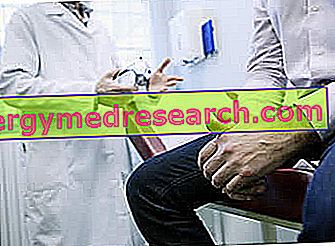Generality
TURP, or transurethral resection of the prostate, is the surgical procedure whereby the prostate is partially removed in men with benign prostatic hypertrophy and associated urinary problems.

The tool used for the operation is the resectoscope; equipped with a light, a camera and a kind of hook through which electric current flows, the resectoscope is carried to the prostate, through the penis.
TURP is a potentially very effective therapeutic option; however, like any surgical procedure, it can give rise to complications, in some cases even unpleasant.
Prostate: outline of anatomy and functions
The prostate is a gland located just below the bladder, in front of the portion of large intestine called rectum. In shape and size, it looks a lot like a chestnut.
Part of the urethra runs through the prostate, ie the duct that carries urine and seminal fluid outside at the time of orgasm.
Around the prostate, muscles called sphincters take place, the contraction of which makes urine output momentarily impossible, while allowing the release of sperm (ejaculation).
FUNCTIONS
The prostate (or prostate gland) secretes a particular liquid called prostatic fluid, which, mixing with other secretions (for example the liquid produced by the seminal vesicles) and with spermatozoa, constitutes the seminal fluid (or sperm).
Prostatic fluid is vitally important for spermatozoa originating in the testicles, because it guarantees their nourishment, protection (when and if they are inside the vagina) and increased motility.

Figure: the main elements of the male genital apparatus.
The testicles (or didymas) are the male gonads, that is the main reproductive organs of the male. Their job is to produce sperm and male sex hormones (testosterone).
The urethra is a small canal that starts from the bladder, runs along the entire penis (the male reproductive organ) and ends at the level of the glans.
An epididymis and a vas deferens are two small channels that unite a testicle, first, to the seminal vesicles and then to the prostate. Through the epididymis and the vas deferens of the two testicles the spermatozoa flow destined to mix with the seminal fluid and thus constitute the sperm.
What is TURP?
TURP, or transurethral resection of the prostate, is the surgical procedure aimed at the partial removal of the prostate, in people with benign prostatic hypertrophy .
WHAT IS BENIGNA PROSTATIC HYPERROPHY?
When we talk about benign prostatic hypertrophy ( BPH ) or enlarged prostate or benign prostatic hyperplasia, we refer to a volumetric enlargement of the prostate of a non-cancerous nature.
In fact, the enlargement is due to a cellular proliferation of prostate tissue, but without the infiltrative and metastatic powers that characterize a malignant tumor.
Benign prostatic hypertrophy is an alteration strongly linked to advanced age. According to some statistical research, in fact, about 80% of men between the ages of 70 and 80 would suffer.
At present, the precise causes of BPH are unclear. According to the latest research, the hormonal changes that occur with aging would seem to have a particular influence: this would explain why the enlarged prostate is a typical condition of elderly men.
When you run
Doctors resort to TURP when benign prostatic hypertrophy causes compression against the urethra, which can cause urinary problems. Among these problems related to prostate enlargement, the most common are:
- Frequent and urgent need to urinate
- Difficulty in starting urination
- Slow and prolonged urination
- Frequent need to urinate during night rest ( nocturia )
- Intermittent urination
- Sensation of failed bladder emptying
- Inability to urinate. This condition can have a series of consequences, for which TURP is preventive. These consequences include:
- Recurrent urinary tract infections
- Damage to the bladder and / or kidneys
- Urinary incontinence
- Bladder calculations
- Presence of blood in the urine
IN THE PRESENCE OF AN IPB, IS IT ALWAYS BEING A TURP?
In general, doctors use TURP only after the various non-invasive treatments against the enlarged prostate have been shown to be ineffective.
The reason for such an approach is quite obvious: it is always better to try first with less bloody and less risky treatment methods.
Non-invasive therapy for benign prostatic hypertrophy is mainly based on the administration of two types of drugs: antiandrogens and alpha-blockers.
CASES OF IPB IN WHICH TURP IS NOT WORKING
There are circumstances in which, despite the presence of an enlarged prostate, it is not possible to resort to TURP.
These circumstances, which may be temporary or permanent, consist of:
- Recent heart attack or recent heart surgery .
Doctors believe it is good to wait, generally, from 3 to 6 months, before proceeding with the execution of TURP.
- Consistency of neurological disorders, such as Parkinson's disease or multiple sclerosis .
In some individuals, these two morbid conditions determine urinary incontinence, which, as will be seen later, is a possible complication of TURP. Therefore, performing the latter in patients with urinary incontinence could further aggravate the involuntary leakage of urine.
- Consistency of prostate cancer, which requires a radical prostatectomy operation .
Particularly severe malignant prostate tumors require total prostate removal (radical prostatectomy). A partial removal, like the one obtained with TURP, would not be sufficient.
- Recent radiotherapy for the treatment of prostate cancer .
Some malignant prostate tumors can be treated with radiotherapy or brachytherapy cycles (internal radiotherapy). In such cases, it is necessary to wait about 6 months before being able to undergo TURP.
- Consistency of urinary infection, bladder, urethra or kidneys .
To be able to practice TURP, you need to wait for this type of infection to heal.
Preparation
In preparation for TURP (usually a few days before), the patient undergoes a transurethral cystoscopy, through which the treating surgeon examines the precise size of the prostate and observes the other structures of the urinary system.
Therefore, at the end of the procedure or the following day, a doctor-patient interview is scheduled, during which all the pre-operative instructions necessary for the success of the surgery are outlined.
PRE-OPERATIVE INSTRUCTIONS
During the interview between the surgeon who will carry out the intervention (or a qualified member of his staff) and the patient, the patient is informed of:
- Notify if you take antiplatelet drugs, such as aspirin or clopidogrel, or anticoagulant drugs, such as warfarin, due to cardiovascular problems.
Depending on the situation, the surgeon may decide to stop taking these medicines for a few days, as they are preparations that increase blood loss (from surgical wounds, of course).
- Notify if you are allergic to any sedative or anesthetic used during the procedure.
- Introduce yourself, on the day of the intervention, at full fast for at least 8 hours . Therefore, the last meal including food and drink must take place by midnight of the previous day. The only drink allowed a few hours before surgery is water.
This recommendation is explained by the fact that TURP requires spinal or general anesthesia.
- Be followed by a relative or friend, in the phases immediately following the operation. It is important to adhere to this recommendation, especially at the time of discharge, because the after-effects of general anesthesia (slowing reflexes, lightheadedness, etc.) could last even 24 hours. Furthermore, the intervention could prove to be very tiring for the patient.
This interview is an important moment not only for the illustration of the pre-operative measures, but also because it allows the patient to question the medical personnel about doubts and curiosities, which concern TURP.
Procedure
To perform the TURP is a surgeon specialized in problems and diseases of the male urogenital apparatus.
For the procedure, the resectoscope is used, a tubular instrument presenting, at one end, a light, a camera and a sort of metal hook that can emit electric shocks.
In chronological order, the procedural steps are:
Anesthesia
Practiced by an anesthesiologist, it allows the patient not to feel pain during the operation.
If it is a general type, the operated person sleeps and is completely unconscious; if it is spinal, instead, the operated person is conscious but is completely insensitive from the waist down.
Along with anesthetics, the anesthesiologist may also administer antibiotics to reduce the risk of infections.
Inserting the resectoscope
The surgeon accesses the prostate using the resectoscope, which is inserted through the opening of the urethra present in the penis. Obviously, the end of the instrument that is pushed to the prostate level is the one equipped with light, camera and metal hook to emit electric shocks.
Search for prostate tissue to be eliminated and removed
Thanks to the light and the resectoscope camera, the attending physician is able to see, on an external monitor appropriately connected, the exact position of the instrument.
This allows him to "move" with extreme ease and to identify the portion of prostate in excess, which must be eliminated.
Once the abnormal prostate tissue has been identified, it operates the electric current through the metal hook and begins to "dissect" the excess prostate parts.
Glycine-based washes
The resectoscope does not allow to extract the dissected prostate fragments.
In order to do this, the doctor must extract the instrument and insert a bladder catheter in its place, through which, in an immediately following phase, injects a solution containing glycine. In other words, it performs some real washes.
DURATION OF THE PROCEDURE
A TURP intervention can last from a minimum of 60 minutes to a maximum of 90.
LABORATORY ANALYSIS
Although benign prostatic hypertrophy and prostate cancer are two distinct and unrelated conditions, it often happens that the surgeon requests to analyze the cellular composition of the extracted prostate fragments ( prostate biopsy ) in the laboratory.
This is usually a simple precautionary measure.
Post-operative phase
After TURP intervention, a hospitalization period of up to two days is provided. During this time, the medical staff monitors the patient in his vital parameters (blood pressure, cardiac activity, etc.) and explains the various stages of recovery: from the temporary need for bladder catheters, to the most common post-operative sensations, up to the best expedients to optimize post-operative recovery.
BLADDING CATHETERISM
For at least the first 4-7 days following TURP, the patient must use bladder catheters to eliminate urine (NB: this medical practice is called bladder catheterization ).
These catheters are connected to a collection bag, so that those in need can carry out some activities of daily life.
If the size of the operated prostate was truly remarkable, it is likely that bladder catheterization lasts even longer than 7 days.
POST-OPERATIVE SENSATIONS
It is quite common for patients to complain after TURP:
- Pain during urine elimination;
- Frequent and urgent need to urinate;
- Presence of blood (or better, blood clots) in the urine. The use of bladder catheters also serves to facilitate the elimination of these traces of blood.
These disorders are considered normal if they do not last more than 4 weeks. Generally, the improvement is gradual.
Please note . In the case of urine blood, if the problem is such that the urine is completely red, contact your doctor immediately.
HOW TO OPTIMIZE THE RECOVERY PHASE
In order for the post-TURP recovery phase to proceed smoothly and smoothly, surgeons recommend:
- Drink plenty of water so as to favor, through frequent urination, urinary tract cleaning (bladder and urethra in particular), in which the remains of dissected prostate can remain.
- Do not strain the intestine with a bad diet . It is a good idea to eat foods rich in fiber and renounce those that favor constipation.
In the case of constipation, laxatives are likely to be prescribed.
- Do not do tiring activities, such as lifting weights.
Generally, this recommendation is valid for the first 4-6 weeks.
- Do not resume anti-aggregation and / or anticoagulant intakes earlier than established .
- Temporarily refrain from sexual activity . Generally, this advice should be followed for at least 4-6 weeks.
- Do not drive as long as you use bladder catheters.
risks
Like any surgery, TURP is also a complication risk procedure.
These possible complications consist of:
- Retrograde ejaculation . It is the condition for which the sperm emission occurs in reverse, not towards the outside but towards the bladder. It does not alter the sense of pleasure, but it can interfere with the possibility of having children.
According to some statistics, this problem occurs in 9 out of 10 cases, so it is very frequent.
- Urinary incontinence . Involuntary loss of urine affects about 10% of people operated on. Usually, it is urgency incontinence, but, in at least 2% of the cases, it is stress urinary incontinence (or stress urinary incontinence). For those unfamiliar with the differences between these two types of urinary incontinence, it is advisable to consult the dedicated article, present here.
- Urethral stricture . It is the narrowing of the urethra; it concerns about 4% of the people operated.
- Persistent and copious bleeding . They occur very rarely; in fact they affect 3-5% of the people operated.
According to some investigations, individuals with severe benign prostatic hypertrophy would appear to be more at risk.
- Urinary tract infections . They are mainly cystitis and urethritis, affecting 5-10% of patients and requiring antibiotic treatment.
In the most unfortunate cases, they can also be a recurring problem.
- Urinary retention . Due to damage to the bladder muscles, it consists in the complete emptying of the bladder during urination. It affects 2% of treated individuals and is usually a temporary condition, lasting from 4 to 6 weeks.
- Impotence (or erectile dysfunction) . It is the difficulty in having or maintaining an erection. It affects 5-10% of patients and is generally a temporary problem.
- TURP syndrome . It is a rare condition (it affects one patient every 100), which occurs when the urethral canal cells absorb the glycine-based solution (used for washing) and pour it back into the blood.
The initial symptoms are: feeling sick, disorientation, vertigo, headache, ascites and bradycardia.

- Recidivism . There is talk of recurrence, when the condition of benign prostatic hypertrophy reappears with all its symptoms, after a period of apparent healing.
Often, a newly enlarged prostate requires the execution of a second TURP; in these cases, however, the risk of urethral stricture is greater.
Deepening: alternatives to TURP, when this procedure is contraindicated
The possible complications of TURP and the circumstances that make it contraindicated have led doctors and researchers to develop alternative, equally effective therapeutic approaches.
Among these alternative therapeutic approaches, a particular mention deserve: the bipolar transurethral resection of the prostate, the prostatic enucleation with Holmio laser, the prostatic vaporization with laser and the open prostatectomy.
The bipolar transurethral resection of the prostate could very much remind TURP, however it is very different for the type of electric current used and for the composition of the washing solution. In fact, the electric current is bipolar (while in TURP it is monopolar) and the solution for washing contains salts (and not glycine). The absence of glycine in the washing solution means that the risk of the so-called TURP syndrome is no longer run.
Prostatic enucleation with Holmio laser involves the "shredding" of the enlarged prostate through a high energy laser beam. The source of this laser beam is located at the end of an endoscope, which is inserted into the urethra and carried up into the prostate just like the resectoscope for TURP (NB: the two instruments are very similar). Once the excess tissue is fragmented, it is pushed into the bladder and eliminated from there. Compared to TURP, it is less effective in improving symptoms, but faster in hospitalization and in the post-operative recovery phase.
The prostatic vaporization with laser also involves the use of a laser source, but, contrary to the previous case, the removal of the excess prostate takes place by burning.
Finally, open prostatectomy is a delicate surgical procedure, which involves removing the excess prostate through an incision in the abdomen. Therefore, unlike the other procedures mentioned above (including TURP), this is a rather invasive method, which, precisely for this reason, is reserved for very serious cases of enlarged prostate.
Results
For many patients, TURP is an effective treatment that significantly improves quality of life.
Unfortunately, there are always exceptions: there are men who continue to experience the same symptoms as before surgery, despite the success of the latter; there are others that develop a new form of benign prostatic hypertrophy after a few years from the operation, thus requiring a second TURP; finally, there are still others that face complications.
Advantages and disadvantages of TURP in short
Advantages:
- Good chance of reducing the symptoms induced by benign prostatic hypertrophy. This results in a significant improvement in the quality of life.
- Good chance that the effects of TURP are long lasting
- Removed prostate fragments can be analyzed in the laboratory. Therefore, TURP also allows a bioptic examination of the prostate.
Disadvantages:
- It provides for hospitalization and a fairly prolonged recovery phase. There are more "hasty" alternative procedures.
- One man out of 10 must undergo a second TURP procedure 10 years after the first one.
- Some complications are very annoying and can seriously compromise the quality of life of patients.
- There is a reduced probability that TURP has no effect.




